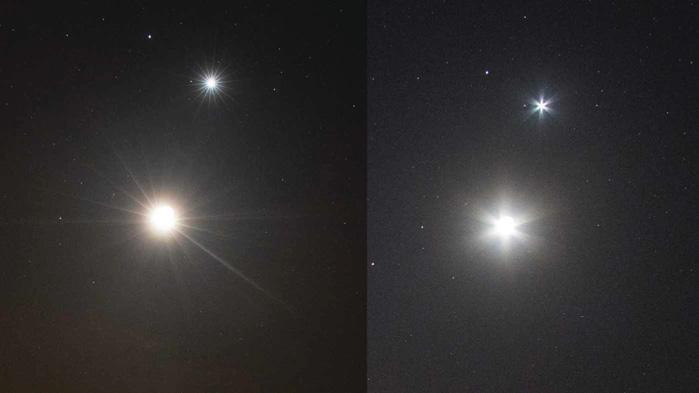
Venus is well-placed in the evening twilight this month, an intense blaze of light, difficult to miss in clear skies. It's an interesting object astronomically, showing subtle atmospheric markings through the eyepiece, as well as displaying striking changes in phase and apparent diameter.
It's interesting for another reason too. Being so intensely bright - the brightest of all the planets - it's essentially a point source at low magnification, and ideal for demonstrating experiments with light. When placed in a dark sky, it's possible to experience its light casting a shadow- okay, it's a dim shadow, but it's one that can be photographed. Being very close to a point light source, the shadow cast is really sharp and well-defined too.
To record this elusive effect, you'll need to be somewhere where there are no other light sources. Even a bright sky can interfere. A west or northwest-facing window is ideal, as long as you can turn all of the lights off. If you can't do this, use a large cardboard box with the opening pointed at Venus. Either way, you'll need a screen on which the shadow will be cast. This can be as simple as a light-coloured wall or several large white sheets of paper.
You'll need a shadow-casting subject as well. This can be a shape cut from card pasted on a window or suspended in front of the box. Then it's simply a case of pointing a camera at the screen, focusing and taking your shot. A high ISO is recommended to keep the exposure times short; take too long and the razor-sharp edge of the shadow will blur as Venus moves relative to the horizon.
Make a rainbow
Denne historien er fra April 2023-utgaven av BBC Sky at Night Magazine.
Start din 7-dagers gratis prøveperiode på Magzter GOLD for å få tilgang til tusenvis av utvalgte premiumhistorier og 9000+ magasiner og aviser.
Allerede abonnent ? Logg på
Denne historien er fra April 2023-utgaven av BBC Sky at Night Magazine.
Start din 7-dagers gratis prøveperiode på Magzter GOLD for å få tilgang til tusenvis av utvalgte premiumhistorier og 9000+ magasiner og aviser.
Allerede abonnent? Logg på

Could We Find Aliens by Looking for Their Solar Panels?- Designed to reflect ultraviolet and infrared, the panels have a unique fingerprint
Researchers searching for life beyond Earth spend a lot of time thinking about what telltale signs might be detectable astronomically. Forms of unambiguous evidence for the presence of life on another world are known as biosignatures. By extension, techno signatures are indicators of activity by intelligent, civilisation-building life.

Antimatter- In our continuing series, Govert Schilling looks at antimatter, the strange counterpart to most of the matter filling our Universe
Particles and corresponding antiparticles are very much alike, except they have opposite electrical charges. For instance, the antiparticle of the electron - known as the positron - has the same tiny mass, but while electrons carry a negative electrical charge, positrons are positively charged.

Where Have All The Milky Way's Early Stars Gone?- Our Galaxy has a curious lack of pristine stars
The Big Bang produced a Universe filled almost exclusively with hydrogen and helium; all other elements - what astronomers call metals - were produced by stars, supernovae and everything that happens later. So if you can pick out a pristine star with no metals polluting it from among the billions in the Milky Way, then you are likely to have a star dating from our Galaxy's earliest days.

Inside The Sky At Night - Two years ago, exoplanet scientist Hannah Wakeford received some of the first data from the JWST
Two years ago, exoplanet scientist Hannah Wakeford received some of the first data from the JWST. In July's Sky at Night, we discovered what she's learned since then.

How to stack DSLR data in Siril
Easily combine multiple frames to boost detailin your astro photos

Lunar occultation of Saturn
You'll need to strike a balance on 21 August to capture the Moon covering the ringed planet

How to plot a variable star light curve
A rewarding project to chart stars that change brightness

Smartphone photography with a telescope
Mary Mcintyre explains how to get impressive night-sky images using your phone

Once-a-century solar storm is overdue
If a Carrington Event struck today it would be catastrophic, says Minna Palmroth

The new era of human spaceflight
There's been a step-change in crewed space missions since the dawn of the 21st century. Ben Evans charts its course and looks ahead to future horizons